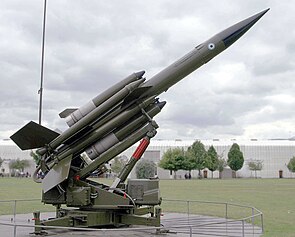Bristol Bloodhound
| Bloodhound Mk.2 | |
|---|---|
| General Information | |
| Type | Long-range surface-to-air guided missile |
| Manufacturer | Bristol Aircraft Company |
| development | 1958 |
| Technical specifications | |
| length | 7.75 m |
| diameter | 546 mm |
| Combat weight | 1,360 kg |
| span | 2,830 mm |
| drive | 4 solid fuel boosters , 2 ramjet engines |
| speed | Mach 2.6 |
| Range | 160 km |
| Furnishing | |
| Target location | INS + semi-active radar target search (SARH) |
| Warhead | 150 kg continuous rod |
| Detonator | Radar impact and proximity fuse |
| Weapon platforms | Fixed position |
| Lists on the subject | |
The Bloodhound was a radar-controlled long-range surface-to-air guided missile made in the UK . It was designed to combat high-flying and high-speed bombers. The system was suitable for all weather conditions.
Technology and commitment

The propulsion of the guided missile was based on a combination of solid fuel motor , consisting of four solid fuel boosters , and two ramjet march engines . The solid fuel boosters accelerated the missile to a speed of Mach 2 within 4.5 seconds . After four to eight seconds, the boosters were dropped and the two ramjet march engines ignited. The cruise engines now accelerated the guided missile to around Mach 2.6. The maximum operational range was over 160 km. The guided weapon could be used at an altitude of 300 to 24,500 m.
The guided missiles were controlled by means of radar . The target was marked by the missile base's fire control radar ; the rocket hit the target through the reflected radar energy. So the missile flew to the ground-lit target and had no active radar itself. The guided missile was fired in the direction of an assumed or calculated meeting point. Course changes were determined by the fire control radar and sent to the guided missile. If a target came within the proximity fuse's response radius , the 150 kg continuous rod warhead was detonated. Depending on the target size, this had an effective range of 60 to 80 m.
variants
- Bloodhound Mk.1: First semi-mobile version to protect British bomber bases. Range 80 km.
- Bloodhound Mk.2: standard and export version. Range 160 km.
- Bloodhound Mk.3: Version for missile defense with 6 kT nuclear warhead. Development stopped. Range over 200 km.
- Bloodhound Mk.4: Mobile version. Development stopped. Range 120 km.
- Bloodhound 21: Simplified, cheaper export version. Development stopped.
distribution
The system was used by the following countries:
Bloodhound in Switzerland
The Switzerland planned the purchase in 1961 and led the Bloodhound system from 1964 in the Army one. The Swiss designation is BL-64. The six permanently installed Bloodhound positions were distributed over Switzerland and could thus cover the entire airspace over Switzerland. A total of 204 guided missiles were ordered from the manufacturer. In 1979, fifty more surplus guided missiles were procured in Sweden. The system was phased out in 1999.
A BL-64 position in Switzerland consisted of one or two batteries with eight guided missile launchers each. There was also a fire control radar, an operations center and various magazines or caverns. In order to guarantee the position's autonomy, the position was assigned additional infrastructure, such as power supply, transmission equipment ( directional beam , telephone switchboard) as well as crew accommodation, kitchen and catering stores.
- Positions
- BL-64ZG: Menzingen in the canton of Zug : two batteries with a total of 16 guided missile launchers , today a museum ( 47 ° 9 ′ 31.32 ″ N , 8 ° 35 ′ 1.32 ″ E )
- BL-64FR: Torny-le-Grand in Canton Freiburg : two batteries with a total of 16 missile launchers ( 46 ° 46 '18.48 " N , 6 ° 57' 29.16" O )
- BL-64AG: Bettwil in the canton of Aargau : two batteries with a total of 16 guided missile launchers ( 47 ° 17 ′ 20.76 ″ N , 8 ° 16 ′ 38.28 ″ E )
- BL-64LU: Emmen in the canton of Lucerne : a training battery with four guided missile launchers ( 47 ° 5 ′ 45.24 ″ N , 8 ° 17 ′ 22.2 ″ E )
- BL-64sO: Höngen in Solothurn : a battery with eight missile launchers ( 47 ° 16 '54.48 " N , 7 ° 38' 46.32" O )
- BL-64ZH: Schmidrüti in the canton of Zurich a battery with eight guided missile launchers ( 47 ° 24 ′ 49.68 ″ N , 8 ° 54 ′ 19.44 ″ E )
Manufacturer
Bristol Aircraft Company , which merged with other companies to form British Aircraft Corporation (BAC) in 1960 .
swell
- Land-Based Air Defense Edition 1998. Jane's Verlag
- Brassey's All the World Air-Defense Systems. Brassey Publishing, 1989
- The Bloodhound surface-to-air guided missile system. DTIG - Defense Threat Informations Group, April 2003

